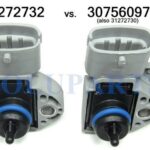Encountering performance problems with your 2003 BMW 330i can be frustrating, especially when accompanied by OBD2 diagnostic codes. This article delves into a real-world scenario faced by a BMW 330i owner, outlining the troubleshooting process and potential solutions for common OBD2 related issues in this model. If you’re experiencing similar symptoms with your 2003 330i and are pulling OBD2 codes, this guide is for you.
Initial Symptoms and OBD2 Codes
The owner of a 2003 BMW 330i, a model known for its inline-six engine and enjoyable driving dynamics, purchased the vehicle as a project car. Initially, the car presented with typical lean condition OBD2 codes:
- P0171: System Too Lean (Bank 1)
- P0174: System Too Lean (Bank 2)
- P1083: Fuel Control Mixture Lean Fault (Bank 1, Sensor 1)
- P1085: Fuel Control Mixture Lean Fault (Bank 2, Sensor 1)
Despite these codes, the car seemed to run reasonably well, managing a highway drive without significant issues. However, after a 45-minute drive, problems began to surface. These included:
- Stalling
- Rough idling
- Puffs of white smoke from the exhaust upon engine shut-off
- Intermittent periods of normal operation followed by recurrence of idle and stalling issues
These symptoms pointed towards potential issues within the fuel delivery, air intake, or emission control systems, common areas of concern in older BMWs.
Initial Maintenance and Parts Replacement
Following online resources and community recommendations for common BMW maintenance, the owner proactively replaced a series of components known to cause similar symptoms. These parts included:
- Fuel pump and filter: Essential for maintaining correct fuel pressure and delivery.
- CCV (Crankcase Ventilation) system and hoses: A crucial system for managing crankcase gases; a cheap aftermarket CCV was initially used.
- ICV (Idle Control Valve): Regulates idle speed and can cause rough idling if faulty.
- DISA valve o-ring: While the DISA valve itself had been replaced in 2011 by the previous owner, the o-ring is a common leak point.
- Vacuum hoses: Including the long vacuum hose running around the valve cover and the larger hose to the air pump, as vacuum leaks are notorious for causing lean codes and idle issues.
- Intake boots (upper and lower): These are prone to cracking and causing unmetered air intake, leading to lean conditions.
- Spark plugs: Routine maintenance item, but important for proper combustion.
- MAF (Mass Air Flow) sensor: Replaced with a Delphi MAF sensor; the MAF sensor measures the air entering the engine and is critical for fuel mixture calculation.
- Serpentine belt and power steering pump & reservoir: Related to general vehicle maintenance, though indirectly relevant to engine performance issues.
- Oil and filter change: Basic maintenance for engine health.
The previous owner had also addressed several maintenance items, including the valve cover gasket, spark plugs, overflow tank, DISA valve, brake components, control arms, and power brake booster.
Despite these replacements, the issues persisted and arguably worsened, indicating a more complex underlying problem.
Escalating Issues: Limp Mode and Rich Running Condition
After the parts replacement, the car’s behavior changed. It would start and idle for a short period, but the idle speed would then increase to around 1200 RPM. Touching the accelerator pedal caused surging, and the engine would not rev beyond 2500 RPM. Furthermore, the car entered “limp mode” when driven, characterized by:
- Limited speed (20-25 mph)
- Gear locking in 1st or 2nd gear
- Illumination of SES (Service Engine Soon), Brake, triangle warning lights, and EML (Electronic Motor Limp) light
Additionally, a strong odor from the exhaust and black, sooty exhaust fumes indicated a very rich running condition, a stark contrast to the initial lean codes.
The car became undrivable due to the persistent limp mode. While the limp mode might temporarily disappear after the car was shut off for a while, the engine still wouldn’t rev properly, and the underlying issue remained.
Seeking Expert Diagnostic Advice for 2003 330i OBD2 Problems
At this stage, facing a combination of OBD2 codes, limp mode, and a rich running condition after addressing common lean condition causes, expert diagnostic advice is crucial. Diagnosing OBD2 issues in a 2003 BMW 330i requires a systematic approach, considering the interplay of various engine management systems. Further investigation should include:
- Re-evaluation of OBD2 codes: Are there new codes present beyond the initial lean codes?
- Live data analysis: Using an OBD2 scan tool to monitor real-time sensor readings (MAF, O2 sensors, fuel trims, etc.) is essential to pinpoint the source of the problem.
- Smoke test: To thoroughly rule out vacuum leaks, especially after CCV system replacement.
- Fuel pressure test: To ensure the new fuel pump is operating correctly.
- O2 sensor testing: Faulty oxygen sensors can cause incorrect fuel mixture adjustments.
- Catalytic converter check: Though less likely initially, a clogged catalytic converter can cause backpressure and performance issues.
Before proceeding with further parts replacements, a comprehensive diagnostic approach is necessary to avoid unnecessary expenses and accurately resolve the 2003 BMW 330i’s OBD2 related performance problems. Expert input from experienced BMW technicians or mechanics familiar with the E46 platform is highly recommended to efficiently troubleshoot this complex issue.
